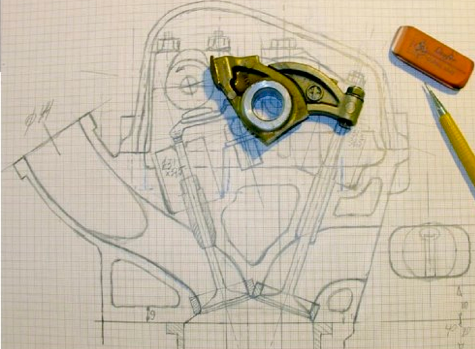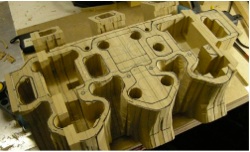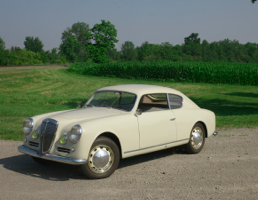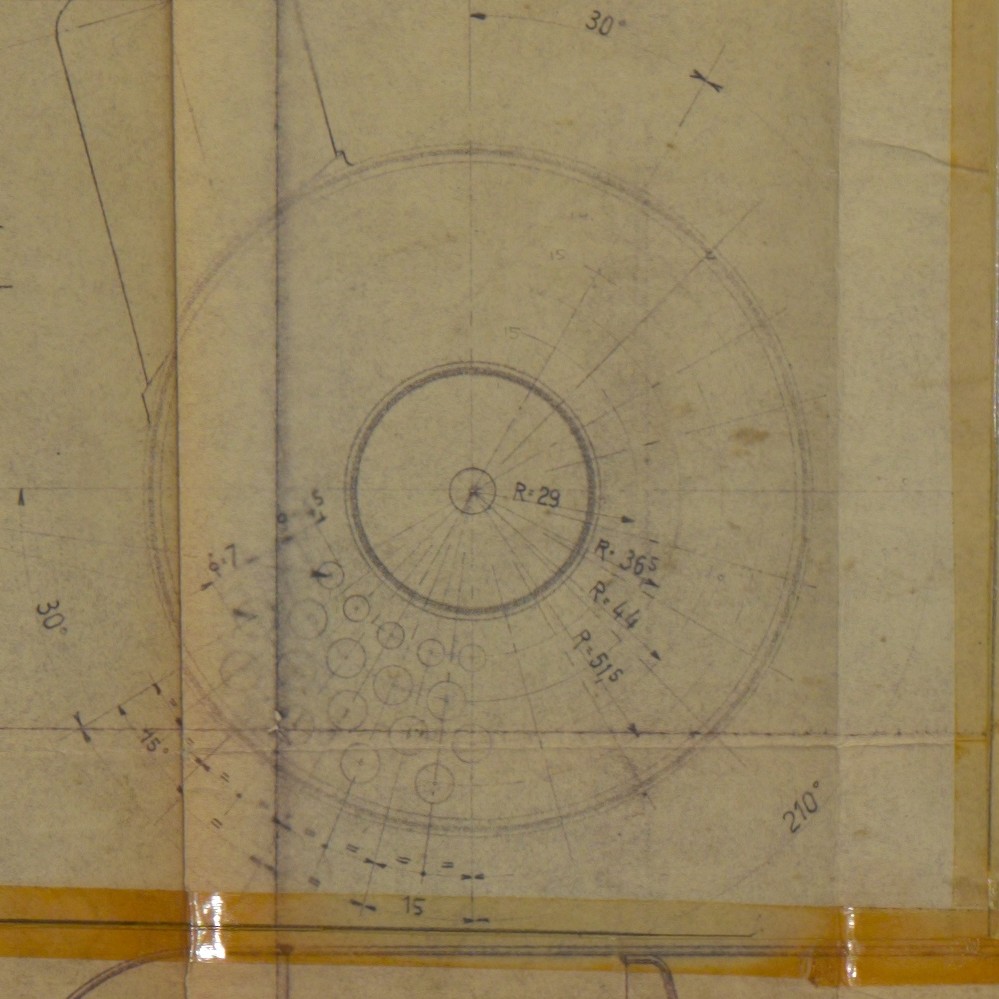Archive for the ‘Aurelia’ Category
Details in the most hidden places
Its all fine to look at fancy drawings of engines, but how about really deep inside the car? From Nigel Trow comes this drawing of a B20 muffler – and in the upper left, there is a small detail of a baffle inside the muffler! Note that it has a nice radial pattern for the baffle holes, interleafed and with the hole size changed to fit. Its a very small bit, one that no one (truly) will ever see it, but boy, you have to love it when designers take such care everywhere!
Lancia suppliers in 1955
From a 1955 Turin Salon book, there was a list of suppliers and subcontractors from that time. Others have been added. If people know of others, please feel free to add them!
LIST OF SUPPLIERS – 1955
(Compiled from the Salon d’Automobile Catalog and other sources)
- Abarth & C.
- AGIP S.p.A.
- Allara Attilio workshop tools
- Allemano – carrozzeria
- Altissimo Ajmone lights and headlamps
- Bertone carrozzeria
- Boano carrozzeria
- Boneschi carrozzeria
- Borletti F.lli. S.p.a. instruments
- Carello Fausto & C. lights and headlamps
- Coriasco Giovanni – carrozzeria
- Emanuel S.p.a. workshop tools
- Farina Pinin S.p.a.- carrozzeria
- Fergat S.p.a. wheels
- F.I.A.M.M. batteries
- F.I.S.P.A. filters
- Fissore F.lli. – carrozzeria
- Fram filters
- Fren-do S.p.a. brake linings
- Frua Pietro – carrozzeria
- Galfer S.p.a. gaskets
- Gallino V. steering wheels
- Giustina machine tools
- Hiebsch R German parts importer
- Industria Vernici Italiane paints
- Lombardi Francis & C. carrozzeria
- Mabo S.pa electric components
- Max Meyer S.p.a. paints
- Michelin Italiana S.p.a. tires
- Nardi & C. S.r.l.
- Nova-Werke S.p.a. pistons/rings
- Paramatti S.p.a. paints
- Pirelli S.p.a. tires
- Rabotti Francesco S.p.a. workshop tools
- Ragni F. badges
- RIV bearings
- Ruspa Officine wheels
- S.P.I.C.A. diesel injection
- Touring carrozzeria
- Trico-Folberth Ltd. wipers
- Trione Ricambi S.p.a.
- Viberti Officine S.p.a. carrozzeria
- Vignale A. & C. carrozzeria
- Viotti carrozzeria
- A.U.R.E.A. concessionaires
- Veglia
- F.lli Borletti
- Jaeger
- Sergio Allais?
- Condor radio
- Autovox radio
- SVAMA bearings (bronzina)
- Fratelli Camozzi linkage hardware
- Alit fuel pump
- Fispa fuel pump
- Weber carburetor
- Solex carburetor
- Arca mirrors
- Universal Giunti universal joints
- ZF gears
- SIMA Torino luggage and fittings
- Houdaille shock absorbers
- Augusto Breda crankshafts
- Riff brake linings
- Ferodo brake linings
- Bertoni & Cotti machining tools
- F.lli Trambusti door handles
Later Additions:
- Trinchero interior fabric
- Cicognani rubber
- Fiat
heads and change
It is interesting to think about change over the lifetime of the Aurelia. Improvements in the heads are one place to look. Above is a series 4 head, below a series 1 head. Notice that in the early head, the geometries of the water passages are designed, and look sensible. But it in the later heads that we can find the hand of expeierence, where the casters and the production testers knew from many engines what worked and what did not. Whether the changes were due to practicality (some passages should be smaller to restrict the flow) or for ease of manufacture is not known. What we can see however is that there was feedback, and lessons learned were incorporated. Thanks to Ed Godshalk for the two heads, although he might not recognize them now cleaned up for show.
Commercials
Sometimes you get diverted. I was doing research into Lancia engineering, and couldn’t make sense out of the commercial (truck) lineup. The names were confusing, the model variations were overwhelming. First, it needed a list of the models and the production volumes – but this was not so easy, as there was no single correct source.
Part of this started with a source for the manuals. A rather incredible tech’l manual (repairs) for the 3RO from 1941 surfaced – and with its 400 pages of extreme detail were 20 color plates. Above is one of them – a section through the then unique 5 cylinder heron head diesel motor. And there are 19 more plates to show…..
Luigi De Virgilio and I went through every bit of printed material we could find on the trucks. We looked at Wim Oude Weernink’s excellent La Lancia, Rosani’s and Amatori’s published numbers in Storia della Lancia, and Lancia Camion published by the Negri Foundation. Needless to say, no count was perfect. The spreadsheet is a bit massive, but most discrepancies have been resolved. Different model names, entries on the wrong lines, addition errors, and how do you count the trucks that Lancia made only the chassis, but not the bodies? Some forgot to count obscure military models …. all part of the puzzle.
Finally an understanding of the models and their names fell into place and was not quite so hard…. once you get into it. Stroke size stays common on the big trucks for decades…. until they sometimes outsource the engine. No one said this was simple.
A copy of the summary diagram of the commercials is below:
Lancia Flavia by Angela Verschoor
Newly published from Holland comes this summary book on the Flavia, 2000 and Superjolly trucks. Its in four languages, has extensive reproductions of the promotional materials for the Flavia. It is a very graphic book. Done with a similar approach to Bruce Lindsay’s “70 years of Trailblazing”, the history of the Flavia is primarily presented through the graphic materials of the period. Like “70 Years”, it comes nicely with a DVD of the materials, and while not yet examined, it is most likely to be thorough and well done – an excellent feature. The book is nicely sized, avoiding the “bigger is better” school of thought, and falls well to hand.
One measure of a car book is “does it make me want one?”, and this does that. I had a Flavia 819 saloon in grad school, and the old pangs were rekindled. I began to see the story of Flavia unfold once again, and remembered its smoothness, somewhat elegant acceleration, and just how pleasant a car it was. Those feelings were amply magnified by the complete presentation of the graphics of the period – a bit stylized in this presentation, but not overly so.
A decision was made to present the limited text in four languages, and while appreciated, the actual text portions of the book are too modest, serving primarily as a guide for the viewer. Those looking for an engineering analysis or even a more detailed research endeavor will have to wait. Primary research extends mostly to the brochures.
It is nice to have a new voice at the Lancia party, and while modestly present here, it is welcomed; more of their thoughts would have been of interest as well.
Data Sheets
A recent reprinting of Aurelia data sheets is like a breath of fresh air. James Steerman, a noted Lancista, has been collecting the factory data sheets for the Aurelia and recently kindly issued a reprint of these hard-to-find items. These sheets were the way the factory communicate their service ideas to the field, and were in place of a workshop manual.
Finding these sheets is never easy. They were issued typically in numerical sequence, in Italian and also sometimes in other languages. They date from about the early 1950’s all the way into the 1960’s. Their numbering system is elusive, and their issuance was probably on an as-needed basis. To my knowledge, no one has a complete run of these – and this collection is timely.
The last list I knew of was compiled by Yale Braunstein in the 1970’s. James has gone beyond this and found some previously unknown sheets.
The compilation is a digital printed, short run, nicely printed, and worth having for reference. The scans are good, the printing nice (the resolution is just great). My quibbles are probably academic – a table of contents would be useful, and more narrative on what guided his selection. Pricing probably reflects the time it took, but….
James is selling them directly through Ebay at:
LANCIA AURELIA FACTORY TECHNICAL DATA BOOK
As James ironically predicted, no sooner can these be published than new information will surface. And that isn’t all bad. Thanks for bringing this forth.

3C – Dutch style
above: images from Heiman’s paper
”, Frank Heimans has been revising an Aurelia motor for his B20 6th series. What started as an effort to fit three carburetors has evolved into an effort to make a new SOHC motor for the Aurelia.
.
His efforts are twofold: to improve breathing on the original motor, through the use of a revised camshaft, manifold variations and fitting three Weber carburetors. WOrk started with some very detailed and precise investigations – pulling out studs, checking for leaks in the block, etc.
There is tremendous enthusiasm and energy in this work. I cannot speak to the engineering, but it looks fairly serious and focused. Getting 3 Webers on the Aurelia motor is not easy – they don’t fit right away, and thus serious work is needed. His interest is in getting more power from these engines – and that is always an interesting goal. It would be helpful to know what the end targets are for the work – but perhaps he is more clear about that in the original Dutch versions – there is a lot more information in the Dutch portion of the site, but some of us have limited language skills. Many thanks for the English translation.
A larger effort has evolved from this, far more ambitious – I think he is trying to make an OHC conversion for the Aurelia, as a revised and modern version of Franco De Virgilio’s SOHC motors of 1953-54. A few samples of these motors still exist, one in California and last heard, one in England.
This is not an easy path, by any means. There are some tricky thresholds to be considered when trying to radically update an Aurelia engine: for example, consider Lancia with 118 hp with a standard camshaft and De Virgilio got 170 hp with a SOHC motor. A Dino motor was 190 hp (I believe) and with a bit of reworking and special cams (use of 4 exhaust cams) the Stratos had 210 hp stock…. it would be good to know where is this effort is aimed. More or less than that? Are there advantages over the Dino? Street or track? Durability? Knowing what the design goals for this would help. Getting 170 hp or more out of these motors would seem like a reasonable target. In fact, it is much harder than one might imagine. Head design is likely a limiting factor. Of course, he’s planning a 3 valve head too….
The analysis of the original Aurelia design work, crankshaft overlap and strength are interesting, albeit difficult to unravel. More analysis of the breathing improvements – measurable preferably – would be interesting. I hope he plans on dyno testing the motor. My own work on a 2.5 liter B24 motor with 2 Webers (Nardi), a new cam and some careful tuning got to 140hp and 140 ft/lbs of torque. I suspect with some more refining of the heads and less torque we could have upped the HP. Curiously we found on the dyno that the HP went down about 3% when the oil got too hot – thus the Flaminia oil cooler began to make sense.



sketch from Heimans showing new ideas for OHC and rocker.
Fobello
A recent trip to Italy allowed for some deeper visits into Lancia lore – including a trip to Fobello, the family homestead.
It is in the far north of Italy, close to Lake Orta and Milan’s Malpensa airport as the crow flies. But we are not crows, and it is a remote alpine valley town, in the middle of lush and heavily wooded hills. Think Colorado mountains, deep forests, and a bit of fantasy land, and you come close. It is a remarkable place, a small town, but full of history for a Lancia buff.
See: Fobello elsewhere on this site.
Cavalitto
A visit to Turin is not complete without a stop at Cavalitto – the shop of Enrico Barlaam, dedicated to older Lancias. He’s on the left above, I’m holding the bag on the right.
Apart from a seemingly endless set of spares, Enrico is blessed with deep knowledge on the cars and the particulars of what works and doesn’t. This trip revealed new fuel pumps for the Aurelia, now built in Italy with a priming lever (for starting) and two diaphragms, to protect against the newer changes in fuel.
Enrico remains active in remaking parts, when there is sufficient demand. New steel wheels for the Aurelia have been made (later series) with the earlier (3/4) to follow.
A good friend to have, a pleasure to visit: Ricambi Lancia
Home again
The B20 comes home, finally. After wintering in Pittsburgh for a motor rebuild with new conrods with plain bearings, the car (and driver) braved 90º + heat, on a drive back across Ohio backroads, Indiana farmland, to arrive in Chicago.
A late afternoon departure from Pittsburgh led to a wonderful evening drive in Ohio farmland – with the roads getting smaller, more obscure and more distant. An evening stop in Mount Vernon, with a lovely inn converted from a motel (recommended), and then a day of more country roads, up into Indiana and a quick visit to the Auburn Cord Duesenberg museum. There were many beautiful cars there, chassis and motors on display, and even Frank Lloyd Wright drawings along with other automotive art. A pleasant surprise.
The run back to Chicago was late at night, to avoid traffic and heat on the expressway. The beige car is remarkably comfortable in extreme heat – while driving, windows open, the light inside is cool and pleasant.
The new motor is quite strong and lovely. There are the odd things to take care of – whining cables to be adjusted – but the car is back to life and going strong. It remains quite compelling on the 2 lane road – cornering flat and without roll. Nice to have it back. My thanks to Walt for the thorough engine rebuild (now running better and finely detailed), and Bob Williams for fitting it and fixing other things. Good Aurelia friends and colleagues.






